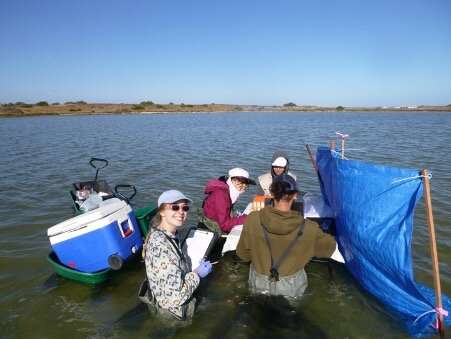Members of the Flinders University Coastal Ecosystem Ecology Lab sampling sediment and macrofauna at The Coorong. Credit: Flinders University
A new article in Science of The Total Environment led by Flinders University describes how transferring poor sediments to more healthy nearby areas of the Ramsar-listed Coorong shallow lagoon, and returning macrobenthic organisms such as worms, can help reboot important sediment nutrient cycling through a process called "bioturbation" to aid food web remediation.
"We know healthy benthic faunal communities exert strong influence on nutrient cycling in coastal marine sediments but many benthic macroinvertebrates are highly susceptible to high salinity and low oxygen in water," says lead author Dr. Orlando Lam-Gordillo, a research associate with the Coastal Ecosystem Ecology Lab research group in Flinders University's College of Science and Engineering.
"We found that this macrobenthic organism relocation helped improve sediment conditions by increasing oxygenation and reducing salinity and sulfide and ammonium concentrations in these 'hostile' sediments."
The project, part of the South Australian Department for Environment and Water's broader "Healthy Coorong, Healthy Basin" program is being managed by the Goyder Institute for Water Research, involving expert collaborators from Flinders University, the University of Adelaide, UniSA, CSIRO and Griffith University.
Goyder Director Dr. Kane Aldridge says: "The Coorong is a wetland of huge local, national and international value which has seen a decline in environmental condition over a number of decades, particularly in the Coorong's South Lagoon.
"This important collaborative work undertaken through the Healthy Coorong, Healthy Basin program has shown that improving sediment conditions can be achieved in a relatively short timeframe if the conditions are right and key organisms are present," Dr. Aldridge says.
The in-situ experiment also showed that restoration of the bioturbation functions of benthic macrofauna, and in particular the worms Simplisetia aequisetis (Polychaeta), modified the sediment biogeochemistry, promoting a healthier state (i.e. lower sulfide, ammonium and organic carbon concentrations) within a few weeks.
"Overall, our research highlights the importance of preserving macrobenthic communities for improving resilience to eutrophication issues, to restore sediment conditions, and to ensure healthy functioning of estuarine benthic ecosystems," the study concludes.
Measures such as this will be vital in maintaining The Coorong's estuarine ecosystems against the pressures of low water inflows from the Murray-Darling basin, climate change and nutrient loads from agriculture and urbanization.
More information: Orlando Lam-Gordillo et al, Restoration of benthic macrofauna promotes biogeochemical remediation of hostile sediments; An in situ transplantation experiment in a eutrophic estuarine-hypersaline lagoon system, Science of The Total Environment (2022). DOI: 10.1016/j.scitotenv.2022.155201
Orlando Lam-Gordillo et al, Loss of benthic macrofauna functional traits correlates with changes in sediment biogeochemistry along an extreme salinity gradient in the Coorong lagoon, Australia, Marine Pollution Bulletin (2021). DOI: 10.1016/j.marpolbul.2021.113202
Journal information: Marine Pollution Bulletin , Science of the Total Environment
Provided by Flinders University
























